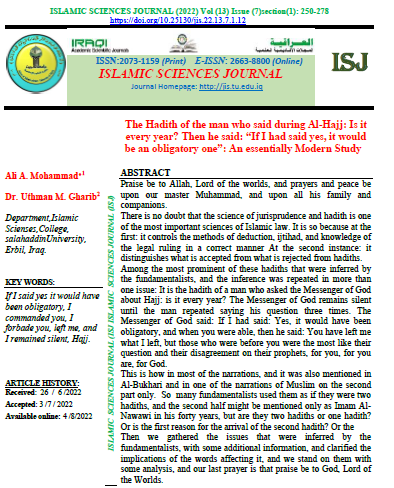The Hadith of the man who said during Al-Hajj: Is it every year? Then he said: “If I had said yes, it would be an obligatory one”: An essentially Modern Study
محتوى المقالة الرئيسي
الملخص
Praise be to Allah, Lord of the worlds, and prayers and peace be upon our master Muhammad, and upon all his family and companions.
There is no doubt that the science of jurisprudence and hadith is one of the most important sciences of Islamic law. It is so because at the first: it controls the methods of deduction, ijtihad, and knowledge of the legal ruling in a correct manner At the second instance: it distinguishes what is accepted from what is rejected from hadiths.
Among the most prominent of these hadiths that were inferred by the fundamentalists, and the inference was repeated in more than one issue: It is the hadith of a man who asked the Messenger of God about Hajj: is it every year? The Messenger of God remains silent until the man repeated saying his question three times. The Messenger of God said: If I had said: Yes, it would have been obligatory, and when you were able, then he said: You have left me what I left, but those who were before you were the most like their question and their disagreement on their prophets, for you, for you are, for God.
This is how in most of the narrations, and it was also mentioned in Al-Bukhari and in one of the narrations of Muslim on the second part only. So many fundamentalists used them as if they were two hadiths, and the second half might be mentioned only as Imam Al-Nawawi in his forty years, but are they two hadiths or one hadith? Or is the first reason for the arrival of the second hadith? Or the
Then we gathered the issues that were inferred by the fundamentalists, with some additional information, and clarified the implications of the words affecting it, and we stand on them with some analysis, and our last prayer is that praise be to God, Lord of the Worlds.
تفاصيل المقالة

هذا العمل مرخص بموجب Creative Commons Attribution 4.0 International License.
COLLEGE OF ISLAMIC SCIENCES, TIKRIT UNIVERSITY. THIS IS AN OPEN ACCESS ARTICLE UNDER THE CC BY LICENSE http://creativecommons.org/licenses/by/4.0/

